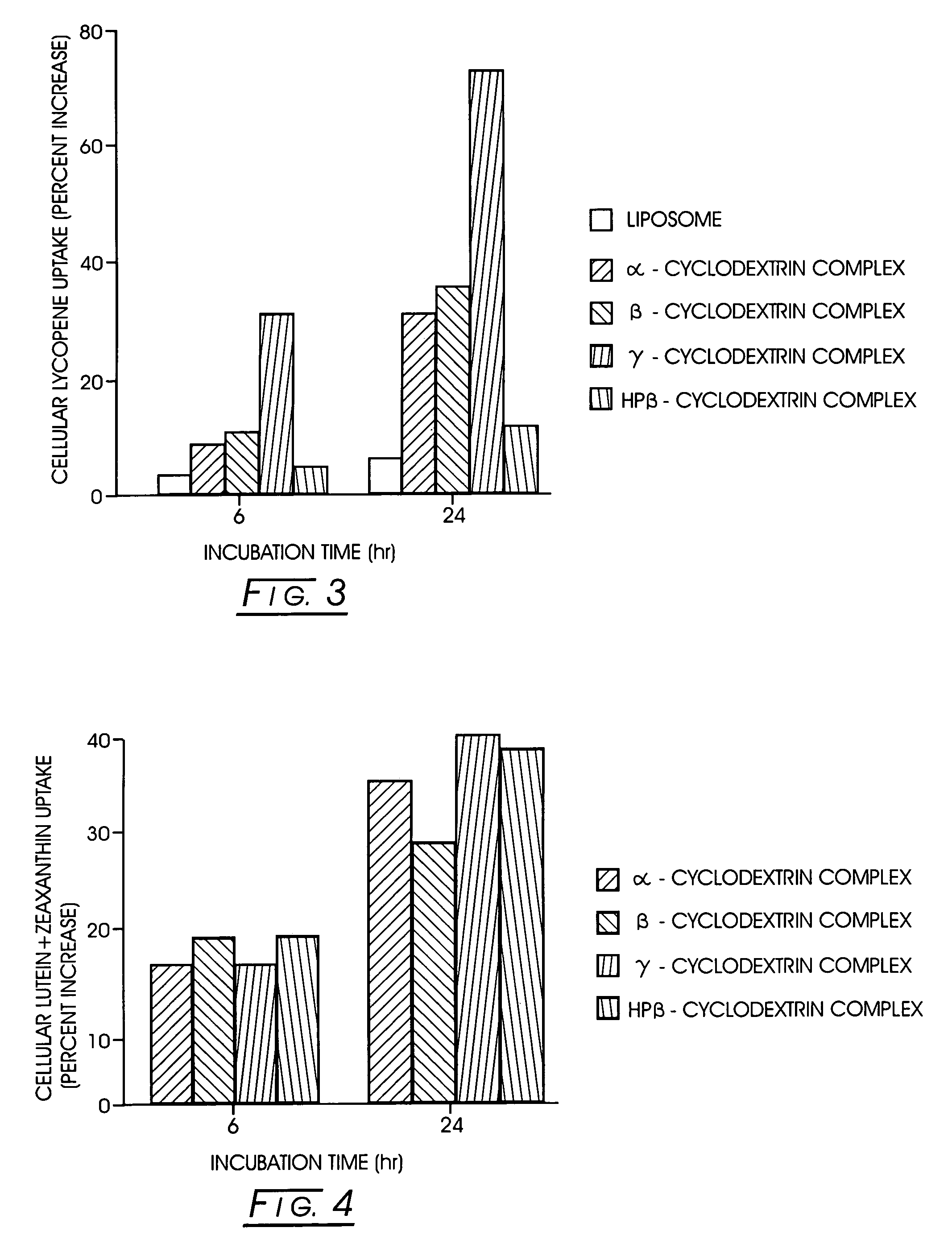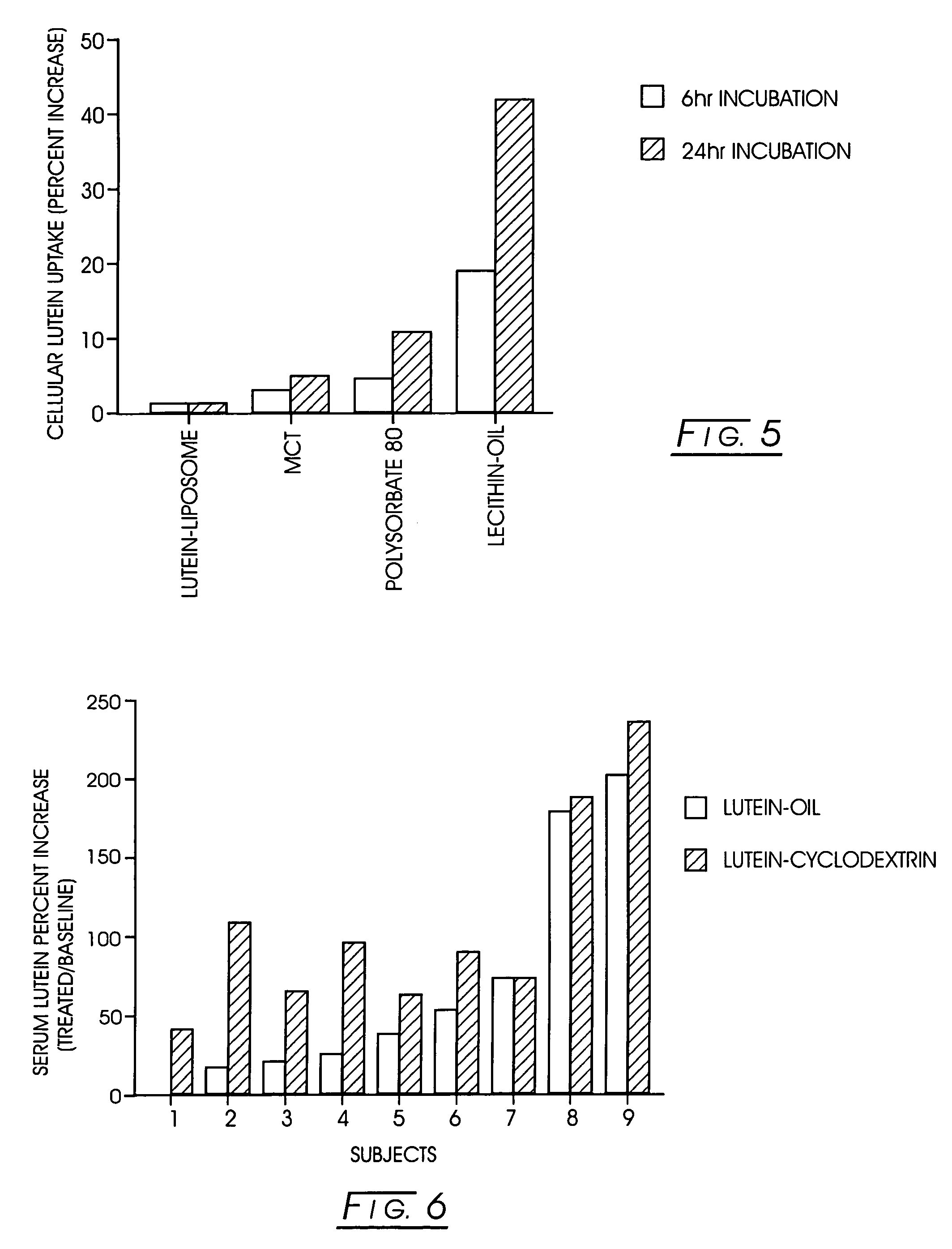Bioavailable carotenoid-cyclodextrin formulations for soft-gels and other encapsulation systems
- Summary
- Abstract
- Description
- Claims
- Application Information
AI Technical Summary
Benefits of technology
Problems solved by technology
Method used
Image
Examples
example 1
Uptake of Lutein from Lutein- / γ-Cyclodextrin Complex Dried by Different Methods In Vitro
[0039]Freeze-dried and spray-dried inclusion complexes containing 20%-21% lutein were used for the studies. The samples were dispersed in phosphate buffered saline (PBS) using sonication.
Cellular Uptake
[0040]Caco2 (ATCC, Rockville, Md.) cells were maintained in high glucose DMEM with 15 mM HEPES and 10% heat inactivated fetal bovine serum, nonessential amino acids, glutamine, and pyruvate in a humidified atmosphere at 5% CO2 and 37° C. The cells were allowed to reach confluency (5-6 days after subculture) and differentiate (14 days) before commencement of the experiment. The test samples were diluted in the culture medium for the experiment. The monolayers were washed with PBS before adding the test samples at known lutein concentration. The cultures were incubated as before for 6 and 24 hours. At indicated times, the medium was removed, the monolayers were washed with PBS, followed by three wash...
example 2
Uptake of Lutein from Various Cyclodextrin Complexes In Vitro
[0045]The in vitro uptake of lutein from the cyclodextrin complexes was tested using the protocol detailed in Example 1. As a comparison, lutein incorporated into liposomes and mixed micelles was tested. The lutein-liposome stock solution was prepared using phosphatidylcholine and free lutein in PBS. The components were dissolved in dichloromethane, mixed at specified concentrations (5% lutein:95% phosphatidylcholine) and the solvent was evaporated using N2. The residue was sonicated in PBS to obtain the liposomes. Mixed micelles were prepared using sodium taurocholate (bile salt), mono-acylglycerol, oleic acid, phosphatidylcholine, lysophosphatidylcholine, and lutein in PBS. The components were dissolved in dichloromethane except for the taurocholate, and mixed at specific concentrations. The solvent was evaporated to dryness. The taurocholate was added as an aqueous solution, followed by the addition of PBS, sonication, ...
example 3
Uptake of Lycopene from Various Cyclodextrin Complexes In Vitro
[0048]The in vitro uptake of lycopene from the cyclodextrin complexes and a liposomal preparation was tested using the protocol detailed in Example 1. The liposomal lycopene was prepared as described in Example 2.
Observations
[0049]The results recorded are displayed below and presented in FIG. 3. Cyclodextrin complexation in general improved the uptake as compared to the liposomal preparation. Of the cyclodextrin complexes tested, the highest uptake was observed with the γ-cyclodextrin complex.
[0050]
TABLE 3A Comparison of the Uptake of Lycopene from CyclodextrinComplexes by Caco2 CellsCellular Lutein Uptake(Percent Increase)Sample6-hr Incubation24-hr incubationLycopene Liposome3.56.3Lycopene / α-Cyclodextrin8.830.9ComplexLycopene / β-Cyclodextrin10.627.1ComplexLycopene / γ-Cyclodextrin31.072.1ComplexLycopene / HP-β-5.011.65Cyclodextrin Complex
PUM
| Property | Measurement | Unit |
|---|---|---|
| Time | aaaaa | aaaaa |
| Time | aaaaa | aaaaa |
| Time | aaaaa | aaaaa |
Abstract
Description
Claims
Application Information
 Login to View More
Login to View More - R&D
- Intellectual Property
- Life Sciences
- Materials
- Tech Scout
- Unparalleled Data Quality
- Higher Quality Content
- 60% Fewer Hallucinations
Browse by: Latest US Patents, China's latest patents, Technical Efficacy Thesaurus, Application Domain, Technology Topic, Popular Technical Reports.
© 2025 PatSnap. All rights reserved.Legal|Privacy policy|Modern Slavery Act Transparency Statement|Sitemap|About US| Contact US: help@patsnap.com



